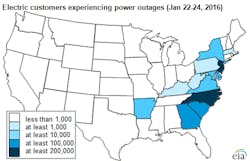Another Big US Storm, Another Argument for Microgrids
Big storms offer a good argument for microgrids. And last week’s blizzard in the eastern United States was no exception, based on government data released today.
The Energy Information Administration reports that more than one million electricity customers lost power when the record-setting blizzard swept across 14 states.
The January 22-23 blizzard was no SuperStorm Sandy – which caused 8.5 million power outages in 2012 – but it did some serious damage to power lines. In fact, power facilities suffered more than any other infrastructure during the blizzard, according to EIA.
500,000 reasons for microgrids in the Carolinas
Utilities prepared in advance for the storm, calling in extra workers, as governors declared states of emergency in 12 states and the District of Columbia.
North Carolina and South Carolina suffered the greatest number of power outages; about 500,000 customers lost power in all. Duke Energy rallied about 7,000 workers to restore power.
New Jersey was hard hit, too, with more than 200,000 outages.
An important Delaware oil refinery also lost power. The PBF Energy’s Delaware City oil refinery is responsible for 15 percent of the East Coast’s refining capacity, about 190,000 barrels per day.
The blizzard drove up demand for natural gas only slightly in the 14 states most heavily affected. Natural gas prices, therefore, remained relatively stable, EIA said. This contrasts with January 2014 when severe cold increased demand for natural gas and prices reached record-highs in parts of the Northeast.
The eastern states snowstorm dwarfed news of another, major power outage on the other side of the U.S. A 7.1-magnitude earthquake in the Kenai Peninsula of Alaska on January 24 that left 15,000 customers without power.
The federal Energy Assurance Daily tracks data on outages and other developments that influence energy systems, flows, and markets. The latest annual report from the federal service showed 15 major power outages (more than 250,000 customers) in 2014 up from 12 in 2013. All of the outages were weather related.
Learn more about the weather argument for microgrids by downloading our free Think Microgrid series.
About the Author
Elisa Wood
Editor-in-Chief
Elisa Wood is the editor and founder of EnergyChangemakers.com. She is co-founder and former editor of Microgrid Knowledge.
